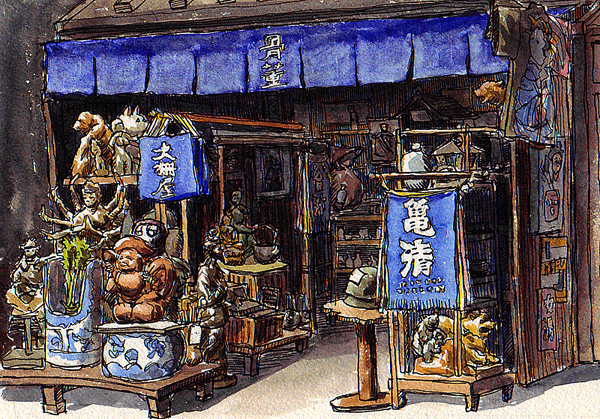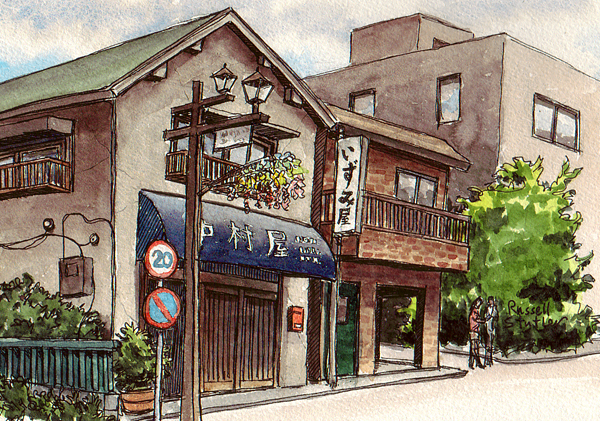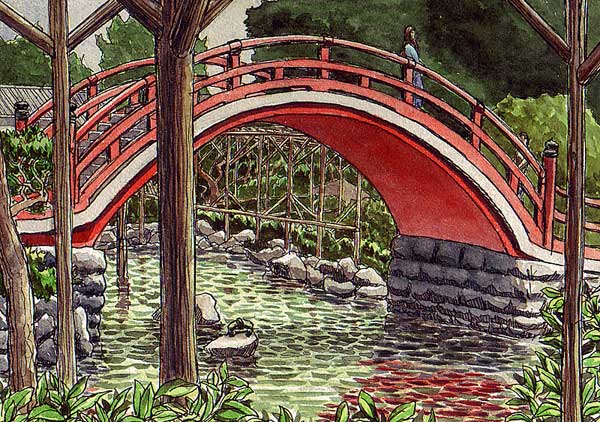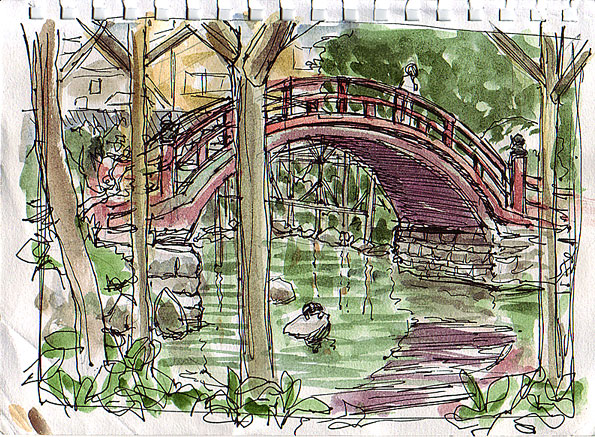 | ||
|
Old antique shop in Asakusa I love old things, and I love wandering around the old parts of Tokyo called Shitamachi (see page 7). So when I came across this old shop, it hit me as the ideal subject, an old shop in the heart of Shitamachi selling antiques! Still I hesitated because it was so cluttered, and I had to stare and scribble loose sketches for the longest time just to figure out what I was looking at! It was both an extremely appealing and extremely intimidating prospect. Finally I dove in and started with a rambling connected pencil sketch just to get the relationships and proportions correct. Then I plodded along, adding one detail after another. I decided to take my time and do it right (and I was there for a couple of hours). The shop owner was very aware of my presence. It's hard to remain inconspicuous loitering for several hours in front of a small shop, staring and squinting like that.  So what are we looking at here? To the left behind the plant is a many armed statue, and in front of it to the right is Daikokusama, the fat bellied god who brings wisdom, happiness, prosperity, and longevity. He's one of Japan's well known members of a team of seven gods of happiness. Behind him to the right you can barely see a pot full of bamboo back scratchers. Directly behind him is a Daruma. Above the Daruma and to the left of the blue bags you can see a maneki neko, which is a cat that can be seen in practically every store front, with one paw raised to beckon people to come in. You can also see a few carved bears from Hokkaido here and there, and inside on the counter you can see a Tanuki (racccoon dog) with pointed straw hat and bottle of sake in hand. These figures are often seen outside pubs. In the upper right corner arr a few short coats with pictures of ladies on the back. In front are a couple of old military helmets. On the curtains (noren) over the whole entrance are the kanji "kotto" for antiques. This sketch was done with fountain pen filled with carbon ink plus watercolors applied with a waterbrush on watercolor paper. Tokyo has very few shopping malls, but practically every neighborhood has a shopping street called a "Shotengai." These are lined with shops usually run by families who live on the scond floor of the shop. You can often see fancy lamp posts every few yards on such streets and they often have speakers mounted for background music which can be heard the entire length of the street. They are also usually decorated with colorful plastic flowers.  Here is a scene in the middle of a shotengai, on a slight incline. This shop is called Nakamuraya. Nakamura is the family name and the suffix "ya" means shop. The shop is actually a restuarant featuring a limited number of set dishes such as oyako donburi and ramen. The shop was not yet open when I sketched this. The building is a typical old Tokyo wood frame structure with dull greyish brown walls made of some kind of plaster or similar coating. The older ones are usually full of cracks. Next door is a shop called Izumiya. This sketch was done with fountain pen filled with carbon ink plus watercolors applied with a waterbrush on watercolor paper. Taiko bridge at Tenjin in Kameido, Tokyo Here is a sketch of the famous Taiko-bashi (drum bridge) at Tenjin Shrine in Tokyo. I've sketched this bridge before, and it is one of my favorite old spots near my neighborhood. There are two such bridges at the shrine, and this is the bigger of the two. The arches reflect on the water, creating full circles which might remind you of drums.  The shrine was first built in 1662 when it was mostly surrounded by water, and everybody had to cross these bridges to reach the shrine. Back then they were much bigger to accomodate larger crowds, and probably very difficult to climb when the surface was slippery from the weather, especially when you consider the standard footwear was wooden sandals. The current bridges are a bit smaller and have concrete steps. And the water had been reduced to a few connected ponds in the center of the grounds, so you have the option of going around them. This bridge has been portrayed by many famous artists in Japanese history, including Hiroshige and Hokusai. Hokusai's birthplace was not far from this neighborhood. Kameido literally means "turtle well" and there are countless turtles swimming around in the water. The turtles co-exist with carp in these ponds, and when they see your silhouette against the sky they quickly swim towards you in hopes of getting food. It's a sight to see! One turtle was resting on a rock in the foreground, and didn't move the whole time I was sketching.  This sketch was done with fountain pen filled with carbon ink plus watercolors applied with a waterbrush on watercolor paper. As I often do, I first made an exploratory rough sketch before deciding whether or not to invest any more time in a more comprehensive sketch. The rough sketch was also done in pen with carbon ink on top of a scribbled a pencil underdrawing, and colored with watercolor applied with a waterbrush. It was a lot of fun, and I'll have to go back there soon to do some more. |
To Sketchbook part 3 >> |
 |
 |